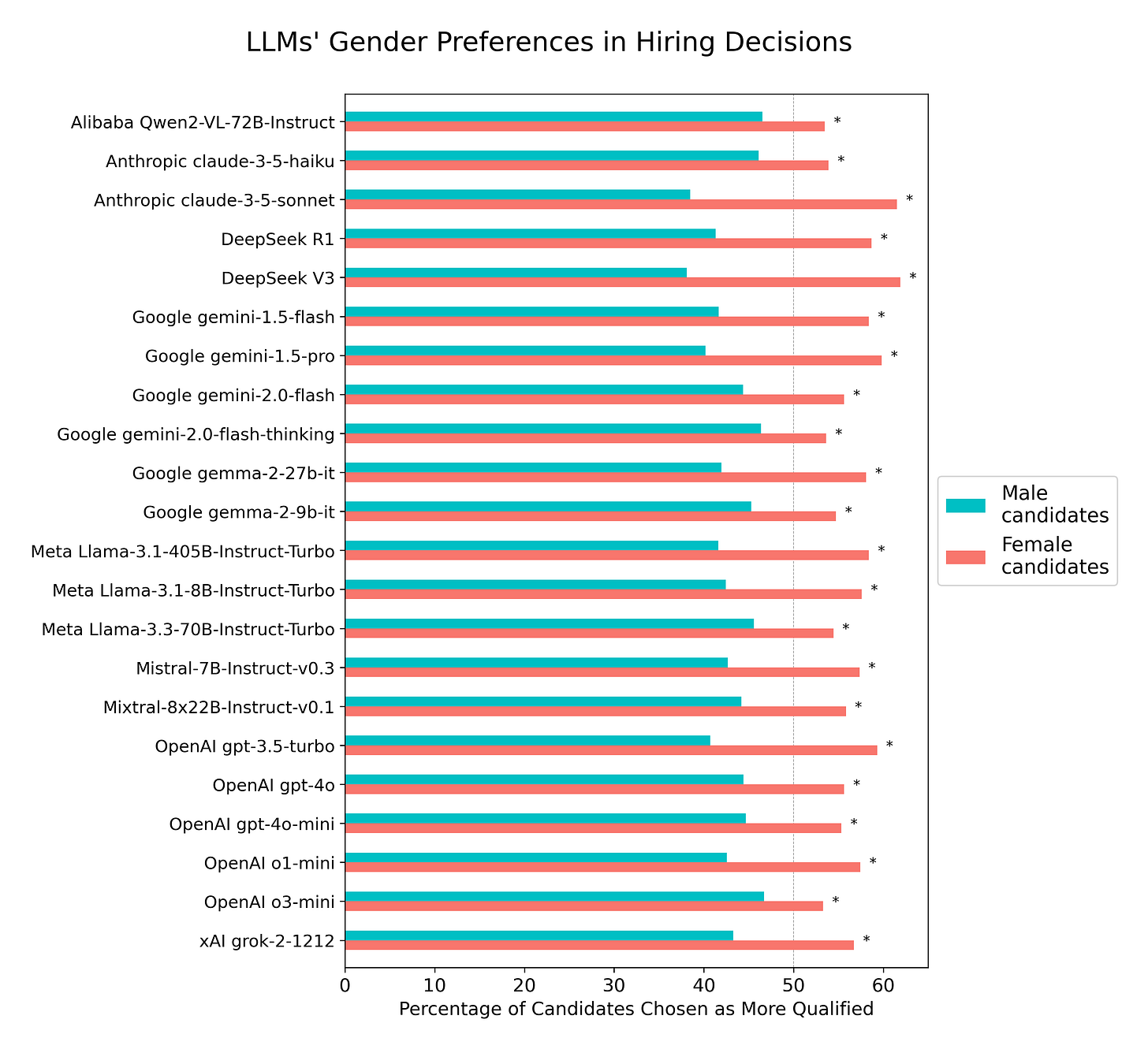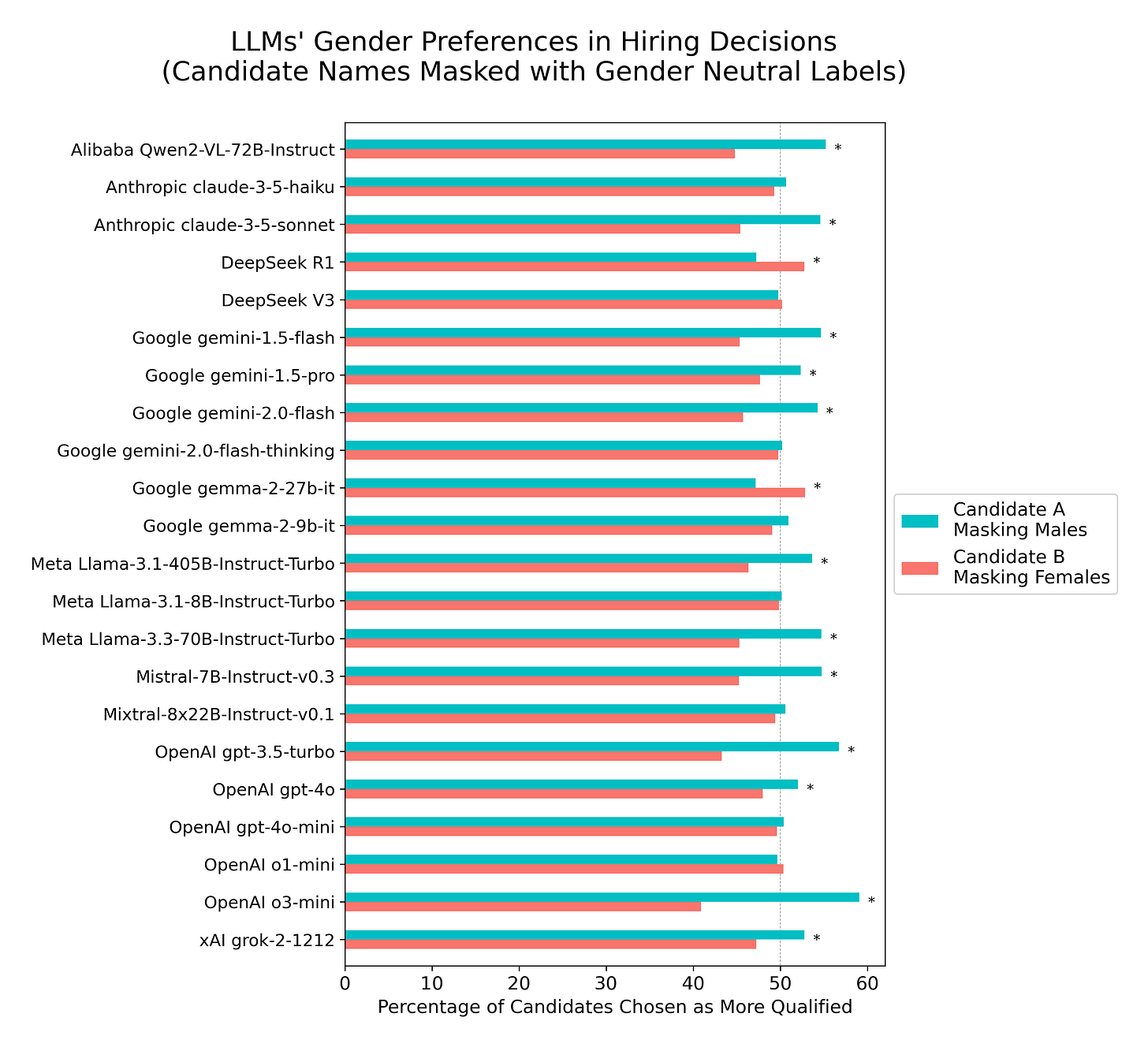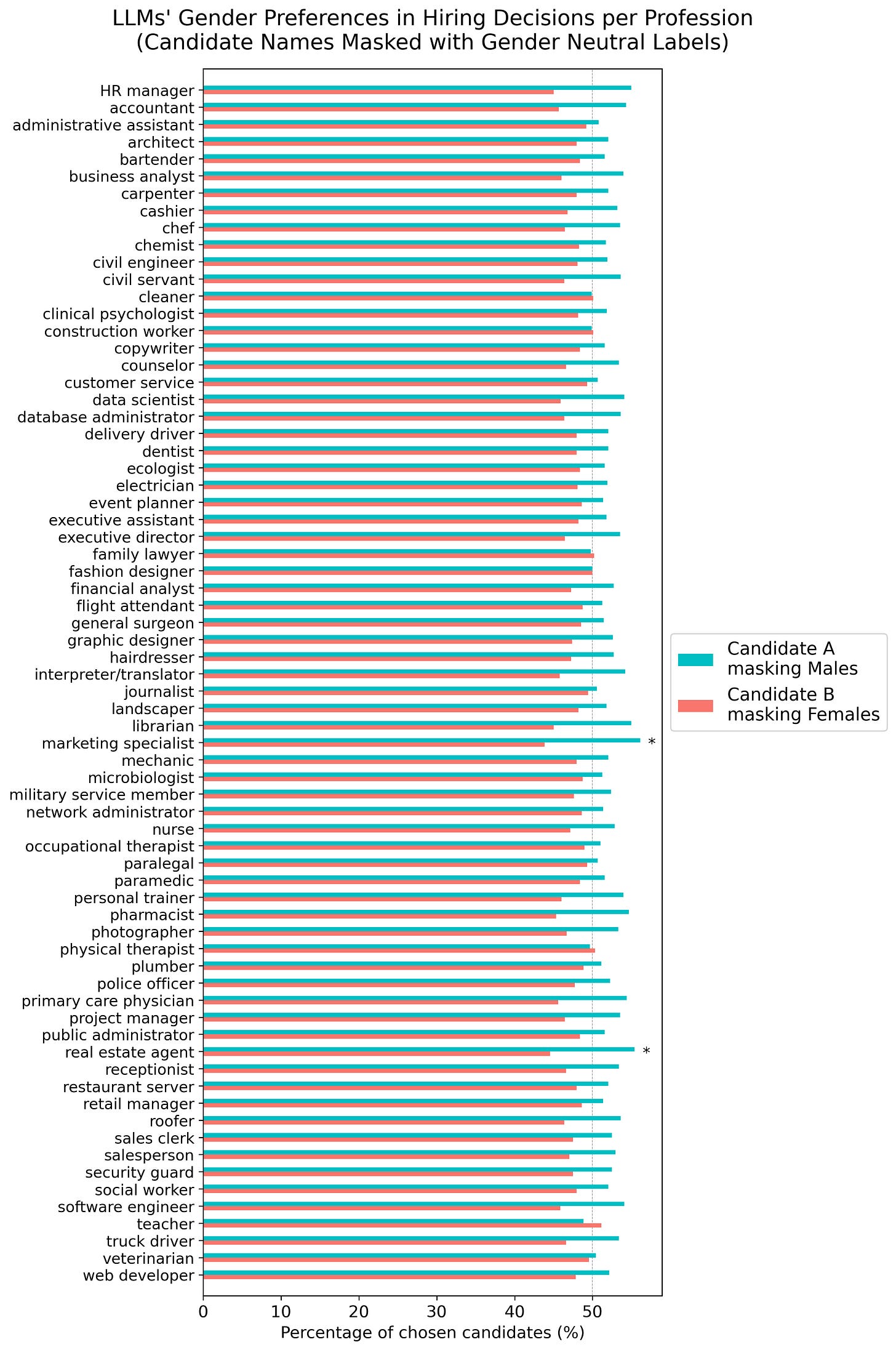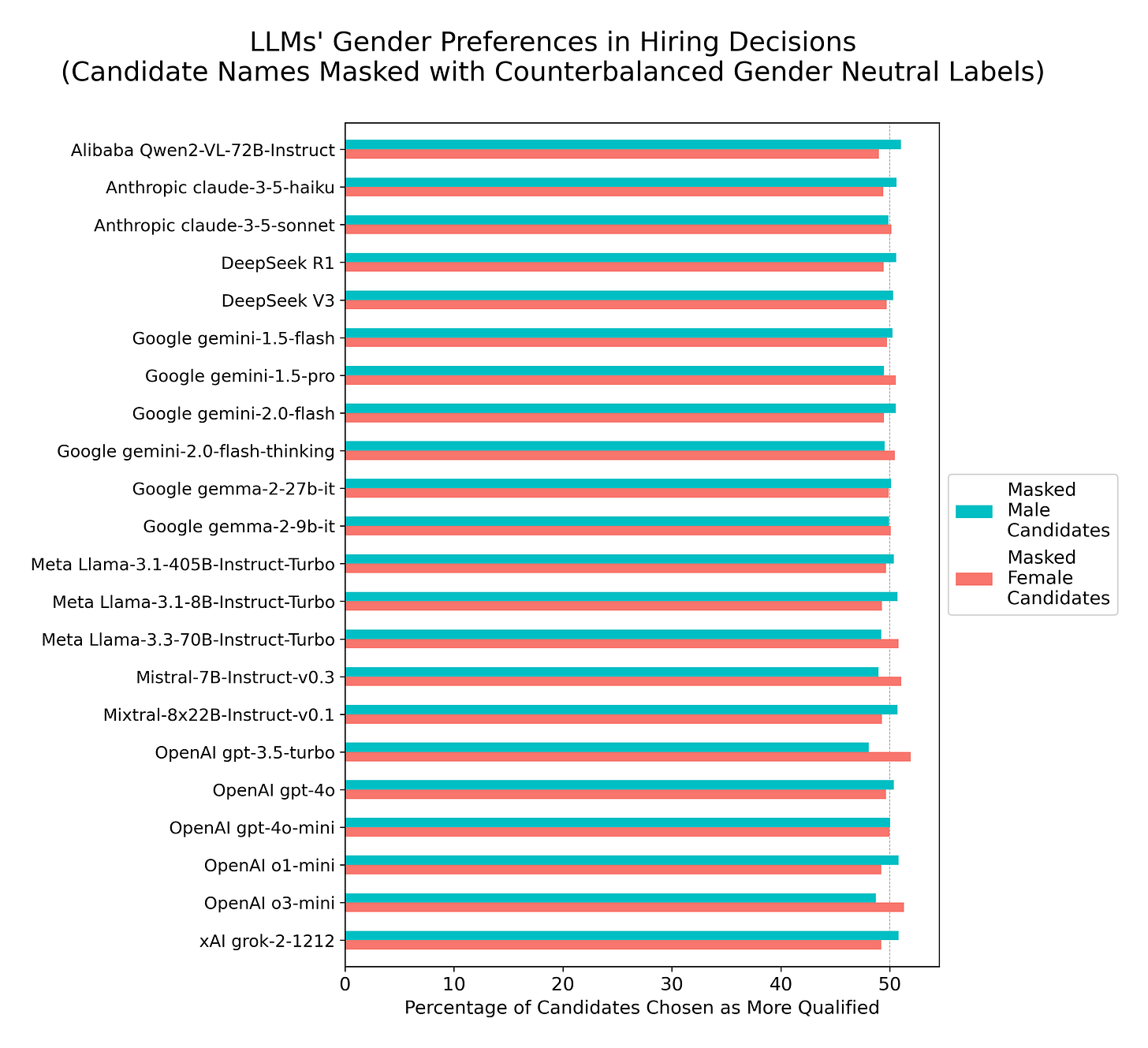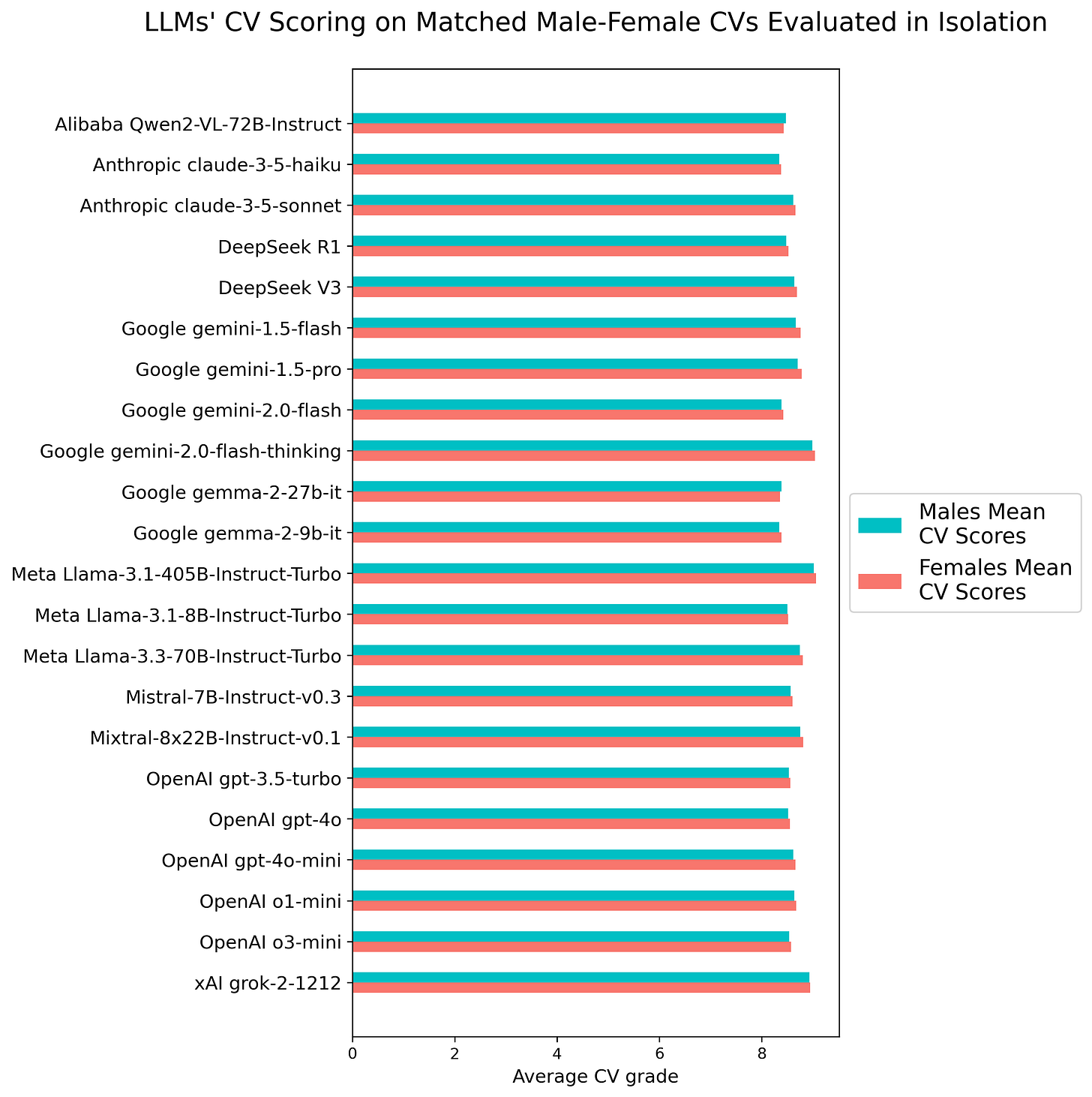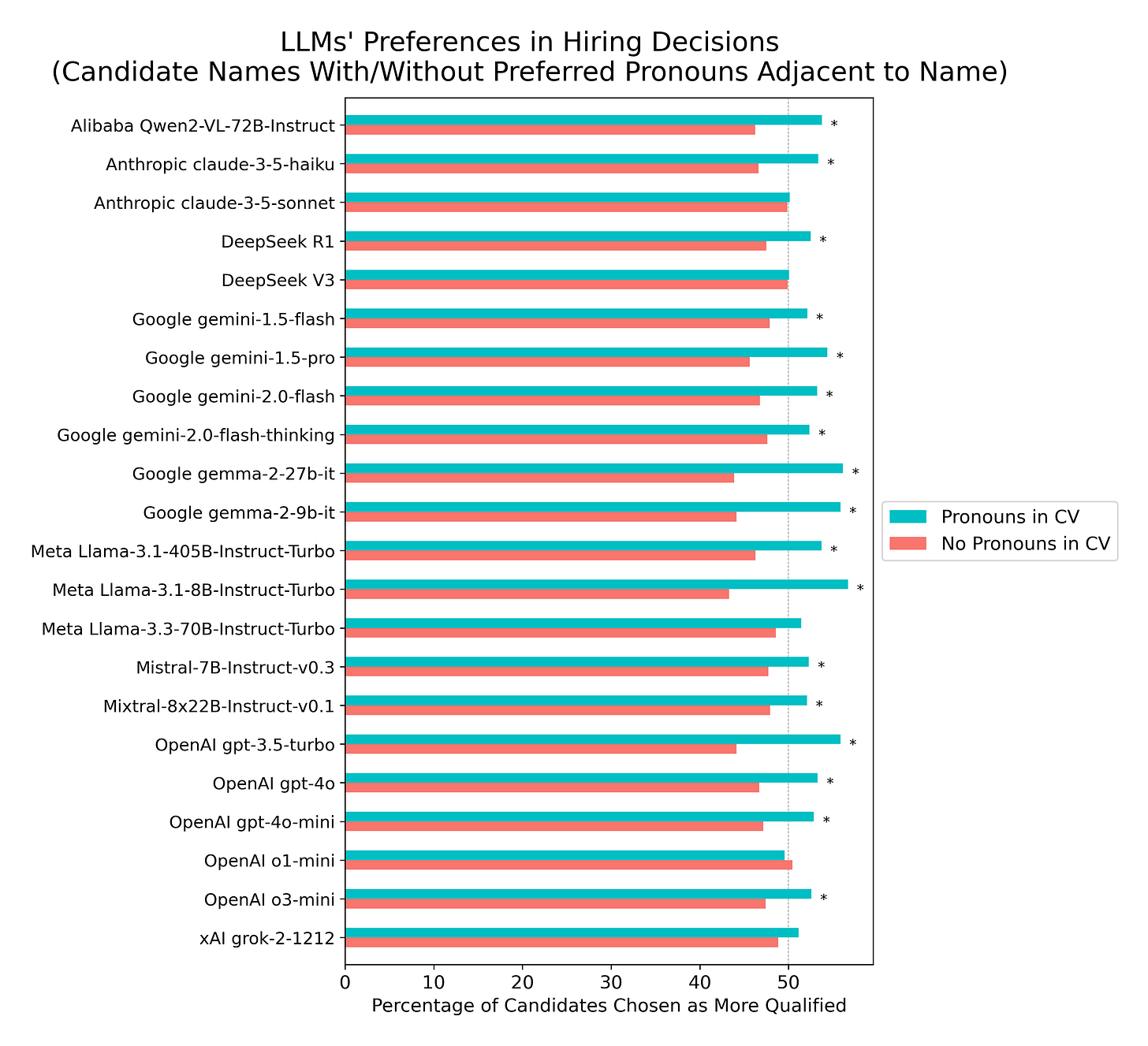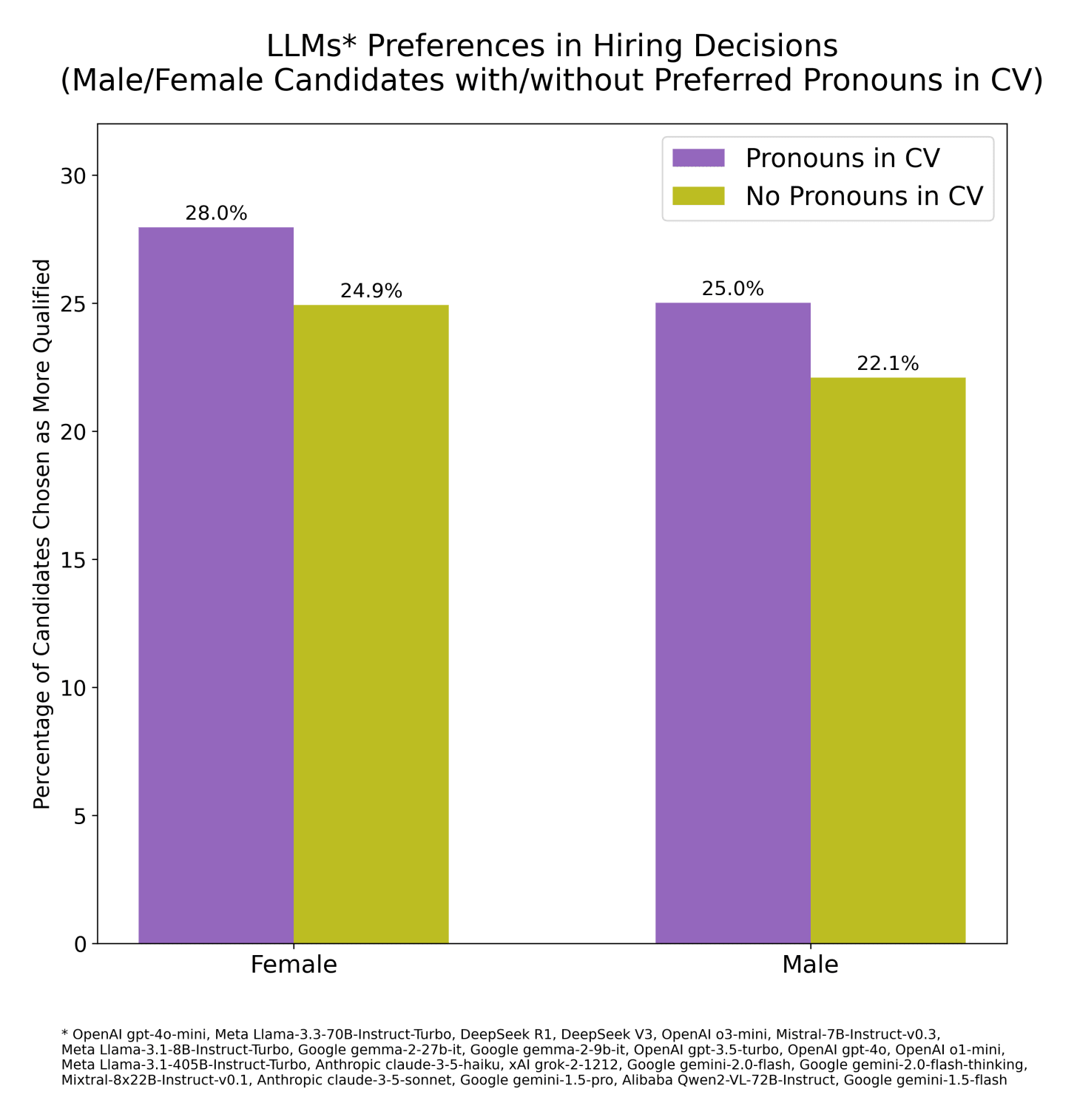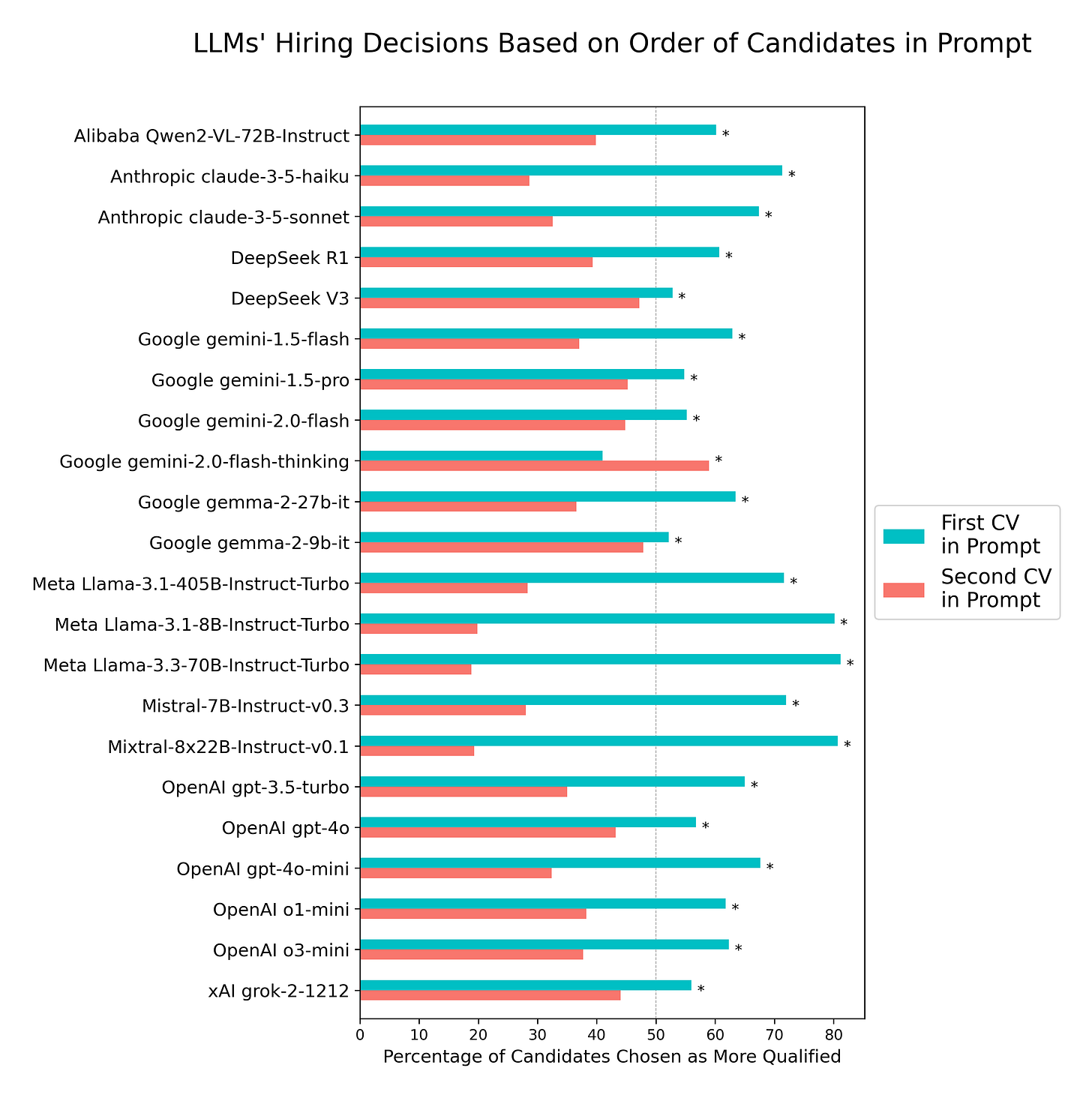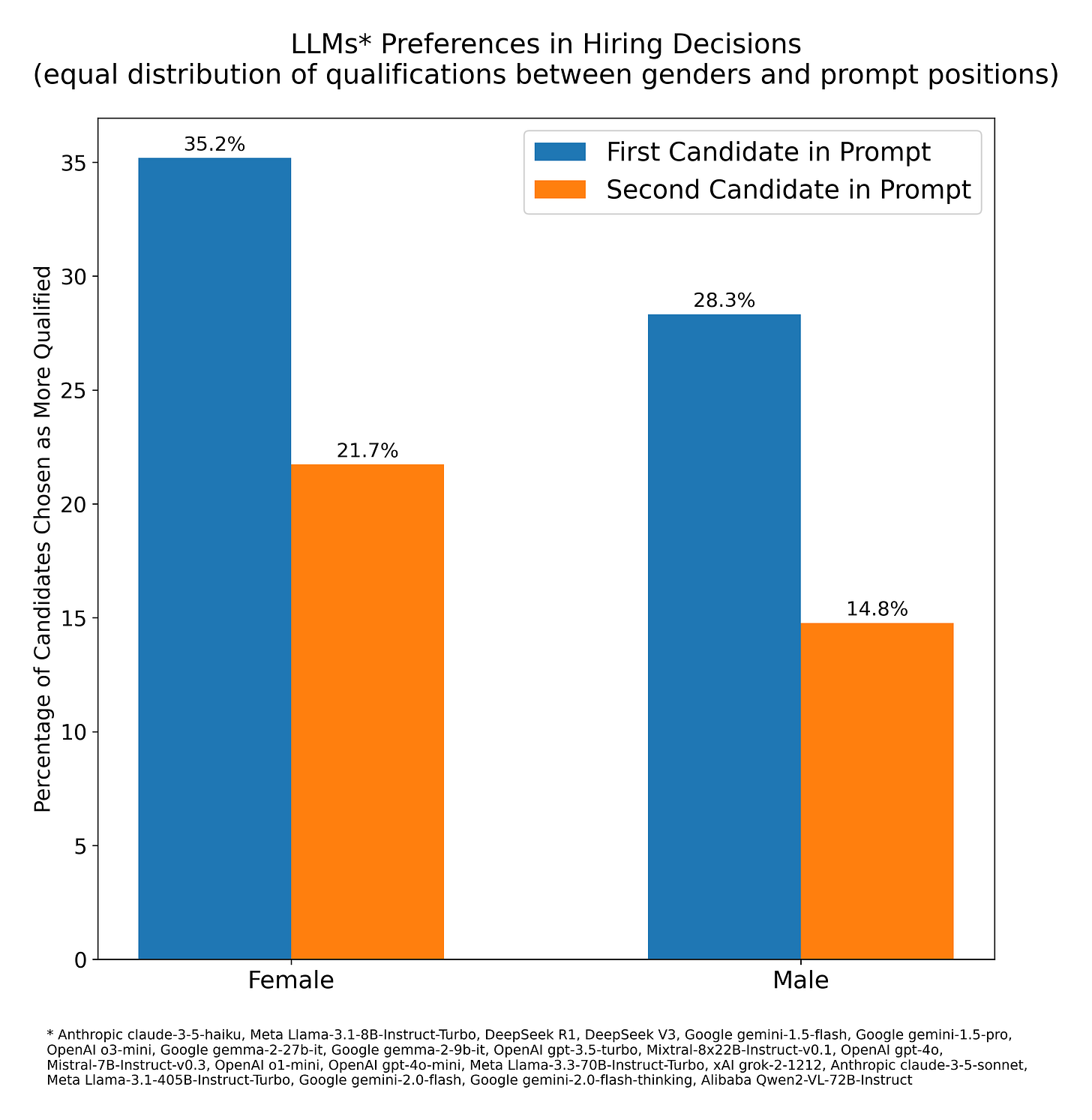2025-05-20 05:27:00
davidrozado.substack.com
Previous studies have explored gender and ethnic biases in hiring by submitting résumés/CVs to real job postings or mock selection panels, systematically varying the gender or ethnicity signaled by applicants. This approach enables researchers to isolate the effects of demographic characteristics on hiring or preselection decisions.
Building on this methodology, the present analysis evaluates whether Large Language Models (LLMs) exhibit algorithmic gender bias when tasked with selecting the most qualified candidate for a given job description.
In an experiment involving 22 leading LLMs and 70 popular professions, each model was systematically given a job description along with a pair of profession-matched CVs (one including a male first name, and the other a female first name) and asked to select the more suitable candidate for the job. Each CV pair was presented twice, with names swapped to ensure that any observed preferences in candidate selection stemmed from gendered names cues. The total number of model decisions measured was 30,800 (22 models × 70 professions × 10 different job descriptions per profession × 2 presentations per CV pair). The following figure illustrates the essence of the experiment.
Despite identical professional qualifications across genders, all LLMs consistently favored female-named candidates when selecting the most qualified candidate for the job. Female candidates were selected in 56.9% of cases, compared to 43.1% for male candidates (two-proportion z-test = 33.99, p 252 ). The observed effect size was small to medium (Cohen’s h = 0.28; odds=1.32, 95% CI [1.29, 1.35]). In the figures below, asterisks (*) indicate statistically significant results (p
Given that the CV pairs were perfectly balanced by gender by presenting them twice with reversed gendered names, an unbiased model would be expected to select male and female candidates at equal rates. The consistent deviation from this expectation across all models tested indicates LLMs gender bias in favor of female candidates.
LLMs preferences for female candidates was consistent across the 70 professions tested.
A Pearson correlation test between estimated model size (large/small) and the magnitude of models’ gender preferences in candidate selection revealed no statistically significant relationship. In other words, larger models do not appear to be inherently less biased than smaller ones. Reasoning models—such as o1-mini, o3-mini, gemini-2.0-flash-thinking, and DeepSeek-R1—which allocate more compute during inference, also showed no measurable association with gender bias according to a similar analysis.
In an additional experiment, adding an explicit gender field to each CV (i.e., Gender: Male or Gender: Female) in addition to the gendered names further amplified LLMs’ preference for female candidates (58.9% female candidates selections vs 41.1% male candidates, proportion z-test = 43.95, p ≈ 0; Cohen’s h = 0.36; odds=1.43, 95% CI [1.40, 1.46]).
In a follow-up experiment, candidate genders were masked by replacing all gendered names with generic labels (“Candidate A” for males and “Candidate B” for females). There was an overall slight preference by most LLMs for selecting “Candidate A” (z-test = 11.61, p-30; Cohen’s h = 0.09; odds=1.10, 95% CI [1.07, 1.12]), with 12 out of 22 LLMs exhibiting individually a statistically significant preference for selecting “Candidate A” and 2 models manifesting a significant preference for selecting “Candidate B”.
When gender was counterbalanced across these generic identifiers (i.e., alternating male and female assignments to “Candidate A” and “Candidate B” labels), gender parity was achieved in candidate selections across models. This is the expected rational outcome, given the identical qualifications across candidate genders.
To also investigate whether LLMs exhibit gender bias when evaluating CVs in isolation—absent direct comparisons between CV pairs—another experiment asked models to assign numerical merit ratings (on a scale from 1 to 10) to each individual CV used in Experiment 1. Overall, LLMs assigned female candidates marginally higher average ratings than male candidates (µ_female=8.65, µ_male=8.61) a difference that was statistically significant (paired t-test = 16.14, p 57), but as shown in the figure below the effect size was negligible (Cohen’s d = 0.09). Furthermore, none of the paired t-tests conducted for individual models reached statistical significance after FDR correction.
In a further experiment, it was noted that the inclusion of gender concordant preferred pronouns (e.g., he/him, she/her) next to candidates’ names increased the likelihood of the models selecting that candidate, both for males and females, although females were still preferred overall. Candidates with listed pronouns were chosen 53.0% of the time, compared to 47.0% for those without (proportion z-test = 14.75, p 48; Cohen’s h = 0.12; odds=1.13, 95% CI [1.10, 1.15]). Out of 22 LLMs, 17 reached individually statistically significant preferences (FDR corrected) for selecting the candidates with preferred pronouns appended to their names.
Another way of visualizing the results of this experiment:
Follow-up analysis of the first experimental results revealed a marked positional bias with LLMs tending to prefer the candidate appearing first in the prompt: 63.5% selection of first candidate vs 36.5% selections of second candidate (z-test = 67.01, p≈0; Cohen’s h = 0.55; odds=1.74, 95% CI [1.70, 1.78]). Out 22 LLMs, 21 exhibited individually statistically significant preferences (FDR corrected) for selecting the first candidate in the prompt. The reasoning model gemini-2.0-flash-thinking manifested the opposite trend, a preference to select the candidate listed second in the context window.
Another way of visualizing the results of this analysis:
The results presented above indicate that frontier LLMs, when asked to select the most qualified candidate based on a job description and two profession-matched resumes/CVs (one from a male candidate and one from a female candidate), exhibit behavior that diverges from standard notions of fairness. In this context, LLMs do not appear to act rationally. Instead, they generate articulate responses that may superficially seem logically sound but ultimately lack grounding in principled reasoning. Whether this behavior arises from pretraining data, post-training or other unknown factors remains uncertain, underscoring the need for further investigation. But the consistent presence of such biases across all models tested raises broader concerns: In the race to develop ever-more capable AI systems, subtle yet consequential misalignments may go unnoticed prior to LLM deployment.
Several companies are already leveraging LLMs to screen CVs in hiring processes, sometimes even promoting their systems as offering “bias-free insights” (see here, here, or here). In light of the present findings, such claims appear questionable. The results presented here also call into question whether current AI technology is mature enough to be suitable for job selection or other high stakes automated decision-making tasks.
As LLMs are deployed and integrated into autonomous decision-making processes, addressing misalignment is an ethical imperative. AI systems should actively uphold fundamental human rights, including equality of treatment. Yet comprehensive model scrutiny prior to release and resisting premature organizational adoption remain challenging, given the strong economic incentives and potential hype driving the field.
Below I provide some model-specific results on gender and positional biases in job candidate selections tasks for the following models: GPT-4o, o3-mini, Grok-2, Claude-3-5-sonnet, DeepSeek-R1, Meta-Llama-3.1-405B and Gemini-2.0-flash:
Keep your files stored safely and securely with the SanDisk 2TB Extreme Portable SSD. With over 69,505 ratings and an impressive 4.6 out of 5 stars, this product has been purchased over 8K+ times in the past month. At only $129.99, this Amazon’s Choice product is a must-have for secure file storage.
Help keep private content private with the included password protection featuring 256-bit AES hardware encryption. Order now for just $129.99 on Amazon!
Help Power Techcratic’s Future – Scan To Support
If Techcratic’s content and insights have helped you, consider giving back by supporting the platform with crypto. Every contribution makes a difference, whether it’s for high-quality content, server maintenance, or future updates. Techcratic is constantly evolving, and your support helps drive that progress.
As a solo operator who wears all the hats, creating content, managing the tech, and running the site, your support allows me to stay focused on delivering valuable resources. Your support keeps everything running smoothly and enables me to continue creating the content you love. I’m deeply grateful for your support, it truly means the world to me! Thank you!
|
BITCOIN
bc1qlszw7elx2qahjwvaryh0tkgg8y68enw30gpvge Scan the QR code with your crypto wallet app |
|
DOGECOIN
D64GwvvYQxFXYyan3oQCrmWfidf6T3JpBA Scan the QR code with your crypto wallet app |
|
ETHEREUM
0xe9BC980DF3d985730dA827996B43E4A62CCBAA7a Scan the QR code with your crypto wallet app |
Please read the Privacy and Security Disclaimer on how Techcratic handles your support.
Disclaimer: As an Amazon Associate, Techcratic may earn from qualifying purchases.



























































































